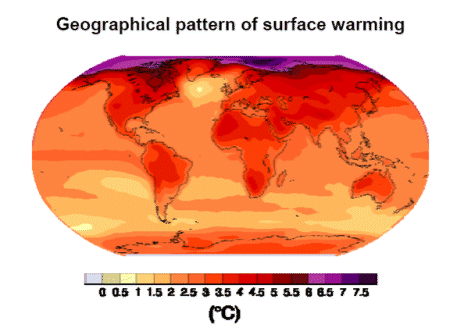Global change
Which consequences of global change are a disaster for coral reefs?
Until the mid 1990's, scientists did not consider global climate change as a serious threat to coral reefs.
But in 1997–1998, the sea temperature rose considerably due to climate change, killing approximately 16% of all corals.
From then on, more and more research was done about the consequences of global change on coral reefs.
Consequently, the above question has not one but multiple answers.
Sea level rise
Climate change induces a rise in air temperature, with the melting of icecaps and glaciers as a consequence. All meltwater ends up in the ocean, which makes sea-level rise inevitable.
Coral reefs can react in different ways, depending on the rate of growth and the rate of sea-level change:
- 'keep up' reefs are able to maintain their crest at or near sea level throughout their history;
- 'catch up' reefs are initially left behind by a sea-level rise, but then recover, usually after the rate of sea-level rise has slowed down;
- 'give up' reefs are reefs which, for different reasons, simply stop accreting.
Sea surface temperature rise
The rise of the sea surface temperature due to global warming is the primary cause of coral bleaching.

An increase in the incidence of coral diseases was noted. This increase is also caused by human activities like higher nutrient concentrations, increased dust transport, toxic chemical pollution…
Atmospheric circulation, precipitations and tropical storms
The change in atmospheric circulation with an increase of precipitations causes more run-off. Increase of run-off will increase the discharge of nutrients and sediments into the sea water. These can spread over the coral polyps which can lead to destruction or death of the polyps because of the lack of sunlight.
Precipitation and river water are both sources of fresh water. When they become very abundant, they cause a decrease of salinity along the shore. And if you know that corals need a certain degree of salinity to survive…
Corals can be also destroyed by giant waves during tropical storms.
Temperature extremes and El Niño
An increase in the duration and magnitude of temperature extremes can be the cause of major coral bleaching. The same happens during intensified El Niño phases.
Too much CO2 in the ocean
The rate of CO2 affects the pH-value of the water. More CO2 decreases the pH-value of the Earth's oceans. This process is called acidification. On one side, it lowers the carbonate accumulation on average, which means a lower extension rate or weaker skeletons in some corals. On the other side, an increased rate of CO2 causes the calcium skeleton of the corals to dissolve more quickly.
Do you want to learn more about acidification? Let's find out!
